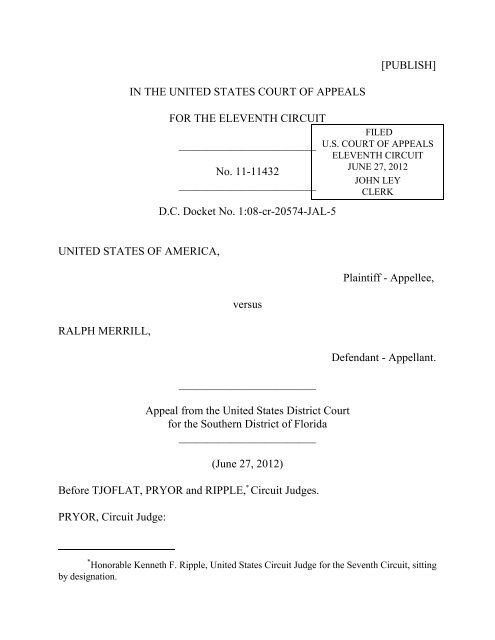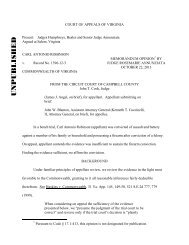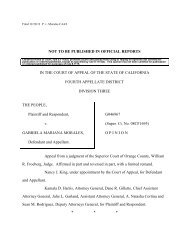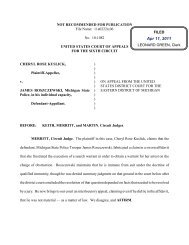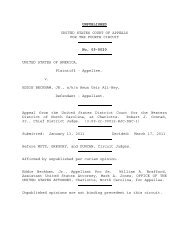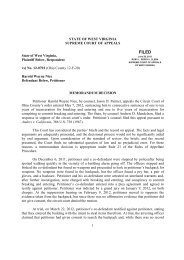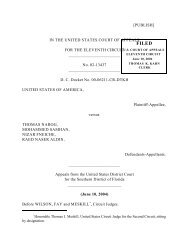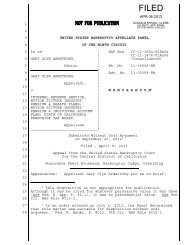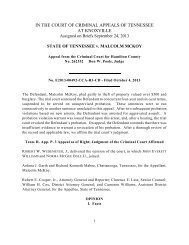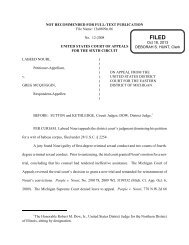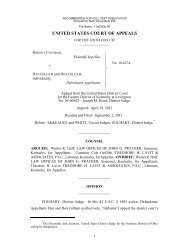United States v. Merrill - Federal Evidence Review
United States v. Merrill - Federal Evidence Review
United States v. Merrill - Federal Evidence Review
You also want an ePaper? Increase the reach of your titles
YUMPU automatically turns print PDFs into web optimized ePapers that Google loves.
[PUBLISH]IN THE UNITED STATES COURT OF APPEALSFOR THE ELEVENTH CIRCUIT________________________No. 11-11432________________________D.C. Docket No. 1:08-cr-20574-JAL-5FILEDU.S. COURT OF APPEALSELEVENTH CIRCUITJUNE 27, 2012JOHN LEYCLERKUNITED STATES OF AMERICA,lllllllllllllllllllllllllllllllllllllll lPlaintiff - Appellee,RALPH MERRILL,versusllllllllllllllllllllllllllllllllllllllll Defendant - Appellant.________________________Appeal from the <strong>United</strong> <strong>States</strong> District Courtfor the Southern District of Florida________________________(June 27, 2012)*Before TJOFLAT, PRYOR and RIPPLE, Circuit Judges.PRYOR, Circuit Judge:Honorable Kenneth F. Ripple, <strong>United</strong> <strong>States</strong> Circuit Judge for the Seventh Circuit, sitting*by designation.
government to grant immunity to a witness. <strong>Merrill</strong> also contends that thegovernment did not produce sufficient evidence to support his convictions formajor fraud and wire fraud. Because all of <strong>Merrill</strong>’s arguments fail, we affirm hisconvictions.I. BACKGROUNDWe divide our discussion of the background of this appeal into two parts.We first discuss the facts that led to <strong>Merrill</strong>’s arrest. We then review theprocedural history of this appeal.A. Conduct That Led to <strong>Merrill</strong>’s ArrestIn August 2006, the <strong>United</strong> <strong>States</strong> Army solicited a bid from AEY, amunitions dealership based in Miami Beach, Florida, for a contract to supply theAfghanistan Security Forces with various types of military munitions includingnearly 500 million rounds of AK-47 ammunition. Ralph <strong>Merrill</strong>, an investor inAEY, was heavily involved in the operations of the company. <strong>Merrill</strong> advisedAEY about how to prepare its bid, inquired with his contacts in the arms businessabout prices of the ammunition to be supplied under the contract, and attested tothe Army that AEY had experience performing this type of contract. When theArmy requested further details about the financial viability of AEY, <strong>Merrill</strong>provided letters on behalf of two of his companies that promised to loan a total of3
$36 million to AEY in support of the contract. <strong>Merrill</strong> and Efraim Diveroli, thepresident of AEY, agreed that they would split the profits from the Afghancontract evenly. AEY submitted a final bid price of $298 million, and the Armyawarded it the contract.The contract provided that for two years AEY would supply certainammunition to the Afghan National Police and the Afghan National Army asneeded. The contract required AEY to certify that each shipment of ammunitionwas serviceable and conformed to the requirements of the contract. A specificquestion on the certificate of conformance asked where the ammunition wasmanufactured.The contract expressly incorporated a Defense <strong>Federal</strong> AcquisitionRegulation Supplement clause that provided that “[a]ny supplies or servicescovered by the <strong>United</strong> <strong>States</strong> Munitions List that are delivered under this contractmay not be acquired, directly or indirectly, from a Communist Chinese militarycompany.” 48 C.F.R. § 252.225-7007. This prohibition was included in the e-mail that AEY forwarded to <strong>Merrill</strong> to notify him that AEY had won the contract.David Packouz, a vice-president at AEY, testified that the prohibition is “widelyknown in the arms industry.”The main supplier that AEY used to fill its orders was MEICO, an Albanian4
munitions dealership. When Alexander Podrizki of AEY arrived in Albania tooversee shipping operations, he noticed Chinese characters on the wooden cratescontaining the ammunition and notified Diveroli and Packouz. Packouz wasnervous because he knew that AEY could not deliver Chinese ammunition, thatMEICO accounted for approximately 95 percent of the ammunition covered by thefirst two Afghan orders, and that AEY was already late in delivering theammunition.<strong>Merrill</strong>, Diveroli, and Packouz discussed whether the Chinese ammunitionmight be legal because it had been acquired by MEICO in the 1960s and 1970s,before the <strong>United</strong> <strong>States</strong> had enacted an arms embargo against China. Theydecided that Diveroli should ask the State Department if AEY could legally sellthe ammunition to the Army. They chose not to ask the Army if it would acceptthe Chinese ammunition because if the Army said “no,” AEY would have a “bigproblem.” They decided not to seek ammunition from another source becausethose efforts would further delay already overdue deliveries. <strong>Merrill</strong>, Diveroli,and Packouz agreed that, if the State Department informed them that the armscould not be sold legally, they would repackage the ammunition to eliminate theChinese characters and ship it. On April 23, 2007, Diveroli asked the Directorateof Defense Trade Controls Response Team at the State Department in an e-mail if5
it was legal to broker “Chinese Ammunition that has been sitting for about 20years with a company in Albania.” The same day, the State Department repliedthat “US policy . . . would not authorize the transaction. Exceptions to this policyrequire a presidential determination.”On April 25, 2007, <strong>Merrill</strong> sent an e-mail to Packouz and Diveroli thatcontained photographs that showed how to remove the Chinese characters fromthe wooden crates with scraping tools. When they discovered that the tins thatheld the ammunition also had Chinese characters, they decided that they wouldpaint the tins to cover the writing. They then discovered that the hermeticallysealedtins contained paper inside that bore Chinese characters. Althoughremoving the papers required them to destroy the vacuum seal, which could makethe ammunition unsafe for the battlefield, Packouz, <strong>Merrill</strong>, and Diveroli decidedto open the tins, remove the paper, and repackage the ammunition in cardboardboxes.By June 2007, AEY began shipping the repackaged ammunition toAfghanistan. Packouz testified that AEY sent at least 30 certificates ofconformance to Afghanistan that contained the false statement that themanufacturer of the ammunition was MEICO, not the Communist Chinese militarycompanies that had actually manufactured the ammunition. In October 2007, an6
investigator from the Department of Defense and an agent from the <strong>United</strong> <strong>States</strong>Department of Immigration and Customs Enforcement traveled to Albania toinvestigate AEY. At the airport hangar where AEY operated, the investigatorsfound piles of empty ammunition tins with Chinese characters, pallets markedwith “AEY” and the Afghanistan contract number that were loaded with boxes ofloose ammunition, and white burlap sacks filled with brown paper wrappings fromthe ammunition and ammunition data placards with Chinese characters.In January 2008, Agent Albert Wiesner of the <strong>United</strong> <strong>States</strong> Army CriminalInvestigations Command visited an ammunition depot outside of Kabul toinvestigate AEY. A supervisor at the storage facility identified the containers thatheld AEY ammunition. Wiesner obtained random samples of ammunition fromthe containers and photographed the containers, pallets, cardboard boxes, andammunition. The boxes lacked the identifying ammunition data cards that boxesof ammunition ordinarily contain. Wiesner traveled back to Bagram Air Base withthe samples and shipped them to the <strong>United</strong> <strong>States</strong>. Two experts analyzed thesamples and concluded that they were manufactured in China.In April 2008, Defense Criminal Investigative Services Special Agent LuisPerez traveled to Utah to serve <strong>Merrill</strong> with grand jury subpoenas seekingdocuments related to AEY and the Afghanistan contract. The investigators then7
were unaware that <strong>Merrill</strong> was involved in criminal activity with AEY. WhilePerez was in Utah, <strong>Merrill</strong> told him that he was only a financier for AEY. <strong>Merrill</strong>also told Perez that he knew that it was illegal to buy or sell Chinese ammunitionbecause of the embargo.<strong>Merrill</strong> arrived in Miami on May 6, 2008, to prepare for his grand jurytestimony. The next day, he voluntarily met with Assistant <strong>United</strong> <strong>States</strong> AttorneyJames Koukios, Agent Perez, Special Agent Ferdinand Vazquez of the U.S. ArmyCriminal Investigation Division, and an agent of Immigration and CustomsEnforcement. <strong>Merrill</strong> asserted that he first learned the Chinese origin of theammunition in August 2007 when a search warrant was executed on AEY. Hestated that he had not had any communication with Diveroli about concealing theChinese characters on the crates and tins. When confronted with e-mails toDiveroli about that subject, <strong>Merrill</strong> first denied, but then admitted, that he hadwritten the e-mails. Koukios then advised <strong>Merrill</strong> that the interview had reached anew level and explained that <strong>Merrill</strong> had the right to leave, to obtain counsel, or tostay and talk about the e-mails. Koukios informed <strong>Merrill</strong> that he could likely facecharges. Koukios explained that if <strong>Merrill</strong> cooperated, the government could askfor a reduction in <strong>Merrill</strong>’s sentence, and if he pleaded guilty, the governmentwould recommend leniency, but discussions of leniency were general in nature.8
<strong>Merrill</strong> stayed and talked to Koukios and the agents and returned voluntarily aftera lunch break for further discussions. <strong>Merrill</strong> told them that he had learned aboutthe Chinese origin of the ammunition in April 2007 from phone calls and e-mailswith Diveroli. He admitted that when he and Diveroli realized that they would notreceive clearance to ship the Chinese ammunition, they agreed that AEY wouldconceal the origin of the ammunition and continue to ship it. They were now, in<strong>Merrill</strong>’s words, playing a game of “high-stakes poker.”B. Procedural HistoryA federal grand jury returned a superseding indictment that charged <strong>Merrill</strong>with one count of conspiring to commit offenses against the <strong>United</strong> <strong>States</strong> by (a)making material false and fraudulent statements in a matter within the jurisdictionof the Department of the Army, 18 U.S.C. § 1001(a)(2); (b) executing a scheme todefraud the <strong>United</strong> <strong>States</strong> and the Army and to obtain money by means of materialfalse and fraudulent representations in the procurement of property valued at$1,000,000 or more as a prime contractor with the <strong>United</strong> <strong>States</strong>, 18 U.S.C.§ 1031; and (c) using wire communications for the purpose of executing thescheme to defraud, 18 U.S.C. § 1343. The indictment also charged <strong>Merrill</strong> withthirty-five counts of major fraud against the <strong>United</strong> <strong>States</strong> for knowingly executinga scheme and attempting to execute a scheme to defraud the <strong>United</strong> <strong>States</strong> and the9
Army, and to obtain money by means of material false and fraudulentrepresentations in the procurement of property valued at $1,000,000 or more as aprime contractor with the <strong>United</strong> <strong>States</strong>, 18 U.S.C. §§ 2, 1031; and thirteen countsof wire fraud for using wire communications for the purpose of executing ascheme to defraud the <strong>United</strong> <strong>States</strong> and the Army, 18 U.S.C. § 1343.Before trial, <strong>Merrill</strong> argued that the indictment should be dismissed becausethe sale of the Chinese ammunition acquired from MEICO was not prohibitedunder the arms embargo passed by Congress in 2006 or the Department of Defenseregulations that implemented the statute. He contended that the regulation did notapply because MEICO had acquired the ammunition from Communist China fortyyears before AEY acquired it from MEICO and no contract or subcontract with aCommunist Chinese military company existed. The district court denied <strong>Merrill</strong>’smotions, <strong>United</strong> <strong>States</strong> v. AEY, Inc., 603 F. Supp. 2d 1363 (S.D. Fla. 2009), anddenied a later motion to reconsider its order.<strong>Merrill</strong> also argued that the charges against him should be dismissedbecause the government knew that the ammunition was manufactured by aCommunist Chinese military company before it accepted the ammunition. Hesought to introduce evidence to support defenses of public authority, entrapmentby estoppel, and innocent intent. The district court excluded this evidence because10
<strong>Merrill</strong> never alleged that he knew that any government official knew about theChinese origin of the ammunition when AEY was shipping the ammunition. Thedistrict court ruled that any alleged government knowledge was irrelevant to<strong>Merrill</strong>’s proposed defenses because it could not have affected <strong>Merrill</strong>’s specificintent. The court also ruled that the origin of the ammunition was a material factfor purposes of fraud, even if the government knew the origin of the ammunition.<strong>Merrill</strong> filed a pretrial motion to suppress statements he made at the May2008 interview he attended with Koukios, Perez, and Vasquez in preparation forhis grand jury testimony. He argued that the statements were made during pleanegotiations and that the government abused its grand jury subpoena power toforce <strong>Merrill</strong> to engage in the interview. After an evidentiary hearing, themagistrate judge recommended that the district court deny <strong>Merrill</strong>’s suppressionmotion. The district court denied <strong>Merrill</strong>’s motion.<strong>Merrill</strong> also filed a motion to compel the production of the agents’handwritten notes from the May 2008 meeting. The magistrate judge denied themotion to compel without prejudice. During the first trial, and in between the firstand second trials, <strong>Merrill</strong> renewed his motion to compel the production of theagents’ handwritten interview notes. Each time the district court examined incamera the agents’ handwritten notes and the agents’ typewritten report of the11
interview with <strong>Merrill</strong>, which had been provided to <strong>Merrill</strong>. The district courtdetermined that there were no contradictions between the notes and the report andthat there was no exculpatory information in the agents’ handwritten notes. Thecourt also determined that nothing in the notes constituted material covered by theJencks Act. The district court denied <strong>Merrill</strong>’s motion. <strong>Merrill</strong>’s first trial endedin a mistrial when the jury could not reach a verdict.At <strong>Merrill</strong>’s second trial, Packouz and David Black, another AEYemployee, testified that AEY attempted to conceal the true origin of theammunition that it sold to the Army, and Packouz testified that <strong>Merrill</strong> wasinvolved in that scheme. Agents Vasquez and Perez testified about the admissionsthat <strong>Merrill</strong> made to them about his involvement in the fraud. The governmentpresented over 150 e-mails that <strong>Merrill</strong> either sent or received that had to do withthe Army contract. One e-mail from <strong>Merrill</strong> to Diveroli and Packouz containedimages that showed how to remove markings from wooden crates of ammunition.Jerry Miller, a firearm and tool mark examiner with the <strong>United</strong> <strong>States</strong> ArmyCriminal Investigation Laboratory, examined the samples obtained by AgentWiesner in Kabul. He offered expert testimony that the ammunition provided byAEY was manufactured in China. Dr. Tai Ming Cheung, an expert in the Chinesedefense industry, testified that the photographs and ammunition samples obtained12
y Agent Wiesner showed that the ammunition shipped by AEY into Kabul wasmanufactured by Communist Chinese military companies.<strong>Merrill</strong> called Daniel Doudnik, a former employee of AEY, as a witness andthe government noted that Doudnik, an unindicted co-conspirator in the AEYprosecution, might incriminate himself. Doudnik was appointed counsel andinvoked his Fifth Amendment privilege against self-incrimination. <strong>Merrill</strong> arguedthat the district court should force the government to grant immunity to Doudnikor dismiss <strong>Merrill</strong>’s indictment with prejudice because two of the witnesses for thegovernment, Packouz and Black, were co-conspirators who were grantedimmunity. <strong>Merrill</strong> also argued that because the government had granted Doudnikdirect use immunity for statements he gave during an earlier interview, Doudnikcould be compelled to testify about those statements. The district court denied<strong>Merrill</strong>’s motion. <strong>Merrill</strong> then sought to admit a report of an interview betweenDoudnik and Agent Perez as a statement against Doudnik’s interest. The districtcourt examined the report that Agent Perez had prepared and ruled that it was notadmissible because it did not contain a statement by Doudnik against his interest.<strong>Merrill</strong> testified at trial that he sent Diveroli an e-mail that showed how toremove markings from wooden crates so AEY could remove any sign that thecrates held ammunition, which would reduce security threats to the crates. During13
cross-examination, the government asked <strong>Merrill</strong> whether he recalled ever givinga different explanation for the purpose of the e-mail. <strong>Merrill</strong> said that he did not,and the government impeached him with testimony he had given at a suppressionhearing. The government introduced a redacted transcript of <strong>Merrill</strong>’s suppressionhearing testimony, and <strong>Merrill</strong> objected on the ground that it was redacted andallegedly taken out of context. At the conclusion of <strong>Merrill</strong>’s testimony, thedistrict court heard arguments about the redacted transcript and ruled that it wasadmissible.At the conclusion of the trial, the jury found <strong>Merrill</strong> guilty of one count ofconspiracy to commit false statements, major fraud, and wire fraud, 18 U.S.C. §371. The jury also convicted <strong>Merrill</strong> of twenty-one substantive counts of majorfraud and eleven counts of wire fraud, 18 U.S.C. §§ 1031, 1343, and 2. The juryfound <strong>Merrill</strong> not guilty on the remaining fourteen counts of major fraud and twocounts of wire fraud.II. STANDARDS OF REVIEWSeveral standards govern our review of this appeal. We review theinterpretation of a statute de novo. <strong>United</strong> <strong>States</strong> v. Pistone, 177 F.3d 957, 958(11th Cir. 1999). We review the evidentiary rulings of the district court for abuseof discretion. <strong>United</strong> <strong>States</strong> v. Walker, 59 F.3d 1196, 1198 (11th Cir. 1995). The14
denial of a motion to suppress presents a mixed question of fact and law. <strong>United</strong><strong>States</strong> v. Delancy, 502 F.3d 1297, 1304 (11th Cir. 2007). We review the findingsof fact for clear error and the interpretation and application of law de novo. Id.We review the findings of fact related to the Jencks Act for clear error. <strong>United</strong><strong>States</strong> v. Schier, 438 F.3d 1104, 1107 (11th Cir. 2006). We review the sufficiencyof the evidence de novo, with all reasonable inferences and credibility evaluationsresolved in favor of the verdict of the jury. <strong>United</strong> <strong>States</strong> v. Medina, 485 F.3d1291, 1296 (11th Cir. 2007).III. DISCUSSION<strong>Merrill</strong> raises eight arguments on appeal. First, he argues that the regulationthat prohibits the Department of Defense from acquiring ammunitionmanufactured by a Communist Chinese military company does not cover theammunition that AEY sold to the Army and that AEY did not misrepresent amaterial fact when it concealed the true origin of its ammunition. Second, <strong>Merrill</strong>argues that the district court abused its discretion when it excluded evidence ofpurported government knowledge about the Chinese origin of ammunitiondelivered by AEY. Third, he contends that the district court erred when it deniedhis motion to suppress statements he made to a prosecutor and federal agentsduring an interview. Fourth, he argues that the government improperly used a15
grand jury subpoena to compel his attendance at an interview with a prosecutor.Fifth, he argues that the district court abused its discretion by failing to require thegovernment to produce handwritten notes that investigators produced during anunrecorded interview with <strong>Merrill</strong>. Sixth, he argues that district court abused itsdiscretion by admitting a redacted version of a suppression hearing transcript.Seventh, <strong>Merrill</strong> argues that the district court abused its discretion when it refusedto direct the government to grant Daniel Doudnik immunity for his proposedtestimony. Finally, <strong>Merrill</strong> contends that the government did not producesufficient evidence to support his convictions for major fraud and wire fraud.These arguments fail. We address each argument in turn.A. The District Court Correctly Ruled That AEY Was Prohibited from SellingCommunist Chinese Ammunition.<strong>Merrill</strong> argues that the regulation that prohibits the Department of Defensefrom acquiring munitions manufactured by a Communist Chinese militarycompany did not apply to the ammunition that AEY sold to the <strong>United</strong> <strong>States</strong>Army because the Albanian company that sold the ammunition to AEY did notacquire the ammunition from China in contemplation of fulfilling a contract withthe Department of Defense. <strong>Merrill</strong> argues that, because the Department ofDefense regulation does not apply to the ammunition that AEY sold, the origin of16
the ammunition was not a material fact, and <strong>Merrill</strong> could not have defrauded thegovernment by concealing the origin of the ammunition. Section 1211 of theNational Defense Authorization Act for Fiscal Year 2006 provides that “[t]heSecretary of Defense may not procure goods or services . . . through a contract orany subcontract (at any tier) under a contract, from any Communist Chinesemilitary company.” Pub. L.109-163 § 1211, 119 Stat. 3461 (Jan. 6, 2006). Toimplement this rule, the Department of Defense amended the Defense <strong>Federal</strong>Acquisition Regulation Supplement to state as follows: “Do not acquire suppliesor services covered by the <strong>United</strong> <strong>States</strong> Munitions List (USML) (22 CFR part121), through a contract or subcontract at any tier, from any Communist Chinesemilitary company.” 48 C.F.R. § 225.770-2. The regulation requires everysolicitation and contract that involves the delivery of covered munitions to includea clause that provides that “[a]ny supplies or services covered by the <strong>United</strong> <strong>States</strong>Munitions List that are delivered under this contract may not be acquired, directlyor indirectly, from a Communist Chinese military company.” 48 C.F.R. §252.225-7007. This clause was included in the solicitation for bids by the Armyand the contract between AEY and the Army.<strong>Merrill</strong> argues that the language “through a contract or subcontract at anytier” limits the reach of the embargo to those instances when a party obtains17
ammunition from a Communist Chinese military company for the purpose offulfilling a contract with the Department of Defense. He argues that, because hissupplier, MEICO, did not acquire the ammunition from China for the purpose offulfilling a contract with the Department of Defense, AEY did not violate anyregulations when it purchased the ammunition and sold it to the Department ofDefense.<strong>Merrill</strong>’s argument fails. The regulation states that the Department ofDefense may not “acquire supplies . . ., through a contract or subcontract at anytier, from any Communist Chinese military company.” 48 C.F.R. § 225.770-2.Although the regulation contains several explicit exceptions, 48 C.F.R. §§225.770-2–3, it does not contain any exception for munitions that left Chinabefore the rule was enacted. The rule requires that every solicitation and contractcontain a clause that makes clear that munitions “delivered under this contract maynot be acquired, directly or indirectly, from a Communist Chinese militarycompany.” 48 C.F.R. § 252.225-7007. The phrase “directly or indirectly” makesclear that the prohibition covers any ammunition manufactured by a CommunistChinese military company. <strong>Merrill</strong>’s interpretation ignores the phrase “directly orindirectly” and would eviscerate the regulation. Under <strong>Merrill</strong>’s reading, as longas munitions were sent from China to a third party before a Department of Defense18
contract was contemplated, they could later be sold to the Department of Defense.Congress and the Department of Defense could not have intended to include sucha gaping loophole in their embargo.But there is an even more fundamental reason why <strong>Merrill</strong>’s argument iswrong: that is, even if the Defense regulation did not cover the ammunition thatAEY shipped to the Army, <strong>Merrill</strong> still engaged in fraud. To establish that <strong>Merrill</strong>participated in “a scheme or artifice to defraud,” the government needed to proveonly “a material misrepresentation, or the omission or concealment of a materialfact calculated to deceive another out of money or property.” <strong>United</strong> <strong>States</strong> v.Bradley, 644 F.3d 1213, 1238 (11th Cir. 2011). The contract that AEY signedexplicitly prohibited the delivery of ammunition “acquired, directly or indirectly,from a Communist Chinese military company.” <strong>Merrill</strong> and his co-conspirators atAEY knew that the Army would not accept their Chinese ammunition, so AEYmisrepresented that their ammunition was manufactured in Albania. Thismisrepresentation was material because “it ha[d] a natural tendency to influence,or [wa]s capable of influencing, the decision maker to whom it [wa]s addressed.”Id. at 1239.B. The District Court Did Not Abuse Its Discretion When It Excluded <strong>Evidence</strong> ofPurported Knowledge of the Chinese Origin of the Ammunition.19
<strong>Merrill</strong> contends that the district court abused its discretion when itexcluded evidence that purported to show that the government knew that AEY wasdelivering ammunition acquired by a Communist Chinese military company. Heargues that, if the government knew the origin of the ammunition, it would beimpossible for <strong>Merrill</strong> to defraud the government because he could not concealfrom the government what it already knew. <strong>Merrill</strong>’s argument fails.<strong>Merrill</strong> sought to introduce evidence of government knowledge to establishthe defenses of actual public authority, entrapment by estoppel, or innocent intent.Each of these defenses required <strong>Merrill</strong> to “show that he relied on officialgovernment communications before acting in a manner proscribed by law.”<strong>United</strong> <strong>States</strong> v. Johnson, 139 F.3d 1359, 1365 (11th Cir. 1998); see also, <strong>United</strong><strong>States</strong> v. Baptista-Rodriguez, 17 F.3d 1354, 1368 n.18 (11th Cir. 1994). <strong>Merrill</strong>never alleged that he knew about or relied on any government approval when hecommitted his crimes. He alleged only that he later learned that the governmentknew the true origin of the ammunition when he lied to the Army. Accordingly,the district court did not err when it excluded <strong>Merrill</strong>’s evidence as irrelevant. SeeJohnson, 139 F.3d at 1365.<strong>Merrill</strong> argues that the evidence of purported government knowledge is stillrelevant because he could not conceal from the government what it already knew,20
ut we disagree. At bottom, <strong>Merrill</strong> contends that, for the purposes of a fraudconviction, a lie is only a lie if it works. But “a false statement can be materialeven if the decision maker actually knew or should have known that the statementwas false.” <strong>United</strong> <strong>States</strong> v. Neder, 197 F.3d 1122, 1129 (11th Cir. 1999).C. The District Court Did Not Err When It Denied <strong>Merrill</strong>’s Motion to Suppress.<strong>Merrill</strong> contends that his statements to Assistant <strong>United</strong> <strong>States</strong> AttorneyKoukios during meetings on May 7 and 8, 2008, should have been suppressed. Heargues that he had a reasonable belief that he was engaged in plea negotiations.We disagree.A court cannot admit against a defendant “a statement made during pleadiscussions with an attorney for the prosecuting authority if the discussions didnot result in a guilty plea or they resulted in a later-withdrawn guilty plea.” Fed.R. Evid. 410(a)(4). To determine whether a discussion should be characterized asa plea negotiation the trial court must “determine, first, whether the accusedexhibited an actual subjective expectation to negotiate a plea at the time of thediscussion, and, second, whether the accused’s expectation was reasonable giventhe totality of the objective circumstances.” <strong>United</strong> <strong>States</strong> v. Robertson, 582 F.2d1356, 1366 (5th Cir. 1978).The magistrate judge found that, even if <strong>Merrill</strong> had a subjective expectation21
to negotiate a plea, his expectation was unreasonable. The magistrate judge statedthat, at the time of the interview, <strong>Merrill</strong> had no charges pending against him. Hewas free to end the interview or to consult with his attorney, and he declined to doeither even though he was advised of his rights. The magistrate judge credited thetestimony of Agents Vasquez and Perez who testified that any discussions ofleniency were general in nature and that no specific promises were made. Thedistrict court affirmed these findings.No error occurred. There were no pending charges against <strong>Merrill</strong> when thediscussion occurred, and the general discussions of leniency did not transform<strong>Merrill</strong>’s meeting with the prosecutor and federal agents into plea negotiations.See, e.g., <strong>United</strong> <strong>States</strong> v. Cross, 638 F.2d 1375, 1380 (5th Cir. Mar. 1981); <strong>United</strong><strong>States</strong> v. Posey, 611 F.2d 1389, 1390–91 (5th Cir. 1980) (The “statement that [theagent] would bring [the defendant]’s cooperation to the attention of the prosecutorand the court did not give [the defendant] a reasonable expectation that he wasnegotiating a bargain. Rather it is the antithesis of a bargained plea.”).D. The Government Did Not Misuse a Grand Jury Subpoena To Interview <strong>Merrill</strong>.<strong>Merrill</strong>’s argument that the government misused its subpoena powerbecause the government arranged for <strong>Merrill</strong> to be in Miami two days before hisgrand jury testimony instead of immediately before his testimony fails. The22
additional time allowed for a meeting between <strong>Merrill</strong> and Assistant <strong>United</strong> <strong>States</strong>Attorney Koukios at which <strong>Merrill</strong> admitted his role in the AEY fraud. The grandjury subpoena power may not be used by the <strong>United</strong> <strong>States</strong> Attorney’s Office aspart of its own investigative process. <strong>United</strong> <strong>States</strong> v. Elliott, 849 F.2d 554, 557(11th Cir. 1988). But “the <strong>United</strong> <strong>States</strong> Attorney is allowed considerable leewayin attempting to prepare for a grand jury investigation” and “must regularlyinterview witnesses prior to appearances before the grand jury to ensure that grandjurors are not burdened with duplicate information.” Id. at 556–57. The districtcourt did not clearly err when it found no evidence that the government misusedits subpoena power and denied <strong>Merrill</strong>’s motion to suppress.E. The District Court Did Not Abuse Its Discretion When It Denied <strong>Merrill</strong>’sMotion to Compel the Government to Produce Handwritten Notes by AgentsVazquez and Perez.<strong>Merrill</strong> contends that the district court abused its discretion when it deniedhis motion to compel the government to produce the notes taken by Agents Perezand Vazquez during their interviews with <strong>Merrill</strong>. He argues that their notes aresubject to production under the Jencks Act, 18 U.S.C. § 3500, which has beenincorporated into <strong>Federal</strong> Rule of Criminal Procedure 26.2. <strong>Merrill</strong>’s argumentfails.When a party calls a witness, the party who did not call the witness is23
entitled to receive “any statement of the witness . . . that relates to the subjectmatter of the witness’s testimony” and that is in the possession of the party thatcalled the witness. Fed. R. Crim. P. 26.2(a). A witness’s “statement” is defined asfollows:(1) a written statement that the witness makes and signs, or otherwiseadopts or approves; (2) a substantially verbatim, contemporaneouslyrecorded recital of the witness’s oral statement that is contained in anyrecording or any transcription of a recording; or (3) the witness’sstatement to a grand jury, however taken or recorded, or a transcriptionof such a statement.Fed. R. Crim. P. 26.2(f). “‘[S]tatement,’ under the Act, is a term of art;‘Congress[, in enacting the Jencks legislation,] was concerned that only thosestatements which [can] properly be called the witness’[s] own words should bemade available to the defense.’” <strong>United</strong> <strong>States</strong> v. Jordan, 316 F.3d 1215, 1252(11th Cir. 2003) (quoting Palermo v. <strong>United</strong> <strong>States</strong>, 360 U.S. 343, 352, 79 S. Ct.1217, 1224 (1959)).The district court did not abuse its discretion when it denied <strong>Merrill</strong>’smotion. The notes that <strong>Merrill</strong> seeks from the agents were their accounts of<strong>Merrill</strong>’s testimony, not transcriptions of <strong>Merrill</strong>’s words. They are not“statements” under the Jencks Act.F. The District Court Did Not Abuse Its Discretion When It Admitted a RedactedVersion of a Suppression Hearing Transcript.24
<strong>Merrill</strong> contends that the district court abused its discretion by admitting aredacted version of the suppression hearing transcript. <strong>Merrill</strong> alleges that the fulltranscript would show that <strong>Merrill</strong> was attempting to explain his answer to theprosecutor’s question when the magistrate judge interrupted and instructed theprosecutor that his line of questioning was irrelevant. He argues that, becauseadditional portions of the transcript were not admitted, his trial was unfair.This argument has no support in the record. As the district court stated,there is nothing in the transcript to suggest that <strong>Merrill</strong> had not finished his answeror that he was interrupted. There are no dashes in the transcript to indicate aninterruption. <strong>Merrill</strong> presents no evidence to establish that this ruling was anabuse of discretion.G. The District Court Did Not Abuse Its Discretion When It Denied <strong>Merrill</strong>’sMotion to Compel the Government to Grant Daniel Doudnik Immunity for HisTestimony.<strong>Merrill</strong> contends that the district court abused its discretion when it refusedto compel the government to grant Daniel Doudnik immunity for his testimonybecause two of the witnesses for the government were co-conspirators who weregranted immunity. He also argues that Doudnik should have been compelled totestify because <strong>Merrill</strong> sought to introduce at trial only statements that Doudnik25
had provided to the government under an earlier agreement for direct useimmunity. Finally, <strong>Merrill</strong> argues that because Doudnik was not forced to testify,his earlier statements to government agents should have been admitted asstatements against interest. All of these arguments fail.<strong>Merrill</strong> argues that we should follow a decision of the Ninth Circuit thatruled that, “in exceptional cases, the fact-finding process may be so distortedthrough the prosecution’s decisions to grant immunity to its own witness whiledenying immunity to a witness with directly contradictory testimony that thedefendant’s due process right to a fair trial is violated,” <strong>United</strong> <strong>States</strong> v. Straub,538 F.3d 1147, 1166 (9th Cir. 2008), but that decision is inapplicable. In Straub,the prosecution granted immunity or benefits to eleven of its witness, but refusedto grant use immunity to the only defense witness. Id. at 1152–53. In <strong>Merrill</strong>’scase the government did not grant immunity to either of the co-conspirators whotestified. Black was not heavily involved in the conspiracy and was neverindicted, and Packouz pleaded guilty. Further, <strong>Merrill</strong>’s argument is foreclosed byour precedent. We have held that “[f]ederal courts . . . have no authority to grantwitnesses . . . use immunity. Congress has placed the power to grant use immunityexclusively in the Executive Branch.” Grand Jury Proceedings (Williams) v.<strong>United</strong> <strong>States</strong>, 995 F.2d 1013, 1017 (11th Cir. 1993) (internal citations omitted).26
The district court did not abuse its discretion when it denied <strong>Merrill</strong>’s motion.<strong>Merrill</strong> also argues that because Doudnik received direct-use immunity forstatements he made at his interview with the government on April 8, 2008,immunity should have extended to his testimony regarding the same statements attrial, but this argument fails. The government agreed to grant Doudnik direct useimmunity only for statements he made during the interview, not for any laterstatements regarding that information. Any statements by Doudnik at trial wouldnot be covered by the agreement.Finally, <strong>Merrill</strong> argues that statements that Doudnik gave to the governmentduring his April 2008 interview should be admitted as statements against interest.See Fed. R. Evid. 804(b)(3). The district court held that the report wasinadmissible. <strong>Merrill</strong>’s argument fails.The district court did not abuse its discretion by excluding this report. Thereport contained only three quotations. Two of the quotations were statements thatDoudnik asserted were made by Diveroli. The district court was correct toexclude these statements as hearsay within hearsay. See Fed. R. Evid. 801. Thethird quote was Doudnik stating that <strong>Merrill</strong> was a “silent partner” in AEY. Thisstatement was not against Doudnik’s interest. See Fed. R. Evid. 804(b)(3).H. The <strong>Evidence</strong> Was Sufficient To Support Convictions for Major Fraud and27
Wire Fraud.<strong>Merrill</strong> argues that the evidence presented at trial was insufficient to supportthe guilty verdicts for major fraud and wire fraud because the government did notestablish a link between the ammunition that was produced at trial and thepayments that were made by the Army to AEY, but the government presentedoverwhelming evidence of a connection between the ammunition and the contractbetween AEY and the Army. AEY employees Packouz and Black both testifiedthat the AK-47 ammunition that AEY shipped to Afghanistan was manufacturedby Communist Chinese military companies. Agent Wiesner testified as to how heidentified and collected ammunition that AEY had shipped to Afghanistan. Heshipped that ammunition back to the <strong>United</strong> <strong>States</strong>, and two experts analyzed thesamples and concluded that they were manufactured in China. This evidence wasmore than sufficient to sustain a conviction for major fraud.<strong>Merrill</strong> also argues that the wire fraud convictions were not supported bysufficient evidence because the government failed to produce evidence to establishthat <strong>Merrill</strong> had access to any of the proceeds of the wire fraud, but thegovernment had to establish only that <strong>Merrill</strong> participated in a scheme or artificeto defraud and used or caused the use of the wires for the purpose of executing thescheme. Bradley, 644 F.3d at1238–39. The government did not have to prove28
that <strong>Merrill</strong> had access to the proceeds of the fraudulent scheme. The governmentpresented sufficient proof that the wires listed in the wire fraud counts were sent infurtherance of the fraudulent scheme in which <strong>Merrill</strong> was a knowing participant.This evidence is sufficient to sustain his convictions.IV. CONCLUSIONWe affirm <strong>Merrill</strong>’s convictions.AFFIRMED.29


